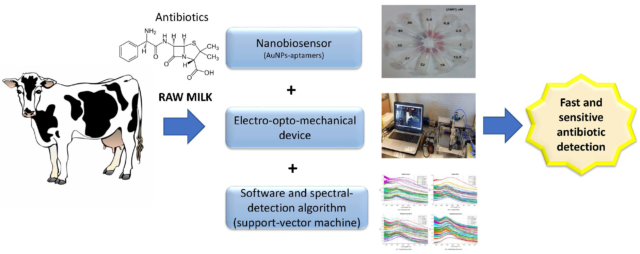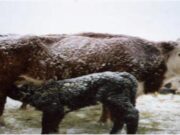
Introduction
Consumers want to be confident that their food supply is free of contamination by herbicides, pesticides, drugs, or antibiotics. The presence of any drugs or antibiotic residues in any livestock product is illegal. Milk supplies containing detectable concentrations of any drugs are not acceptable. Unless drug residues are avoided to protect milk’s reputation as a healthy, safe food, the market becomes jeopardized. Approximately 5-10 percent of the consumer population is hypersensitive to penicillin or other antibiotics and suffers allergic reactions (skin rashes, hives, asthma, anaphylactic shock) at concentrations as low as 1 ppb penicillin. There is concern that small amounts of certain antimicrobial agents may significantly shift the resistance patterns in the microbial population in the human intestinal tract.
Most of the antibiotics are known to interfere with the manufacture of several dairy products. Antimicrobial concentrations of 1 ppb delay starter activity for cheese, butter, and yogurt and of other fermented dairy products. Antibiotics also decrease the acid and flavor production associated with butter manufacture, and they reduce the curdling of milk and cause improper ripening of cheeses. Antibiotic residues in milk and milk products may lead to:severe allergic reactions in sensitive consumers, culture failure and subsequent loss of product, a change in consumer perception of milk being a pure, unadulterated, natural product. All of these concerns may result in major economic losses to the dairy industry.
Need of hour to overcome the effects of antibiotic residue in dairy products:
1. To protect consumers’ health
Antibiotics entering the food chain through dairy products may lead to allergic reactions in humans and antibiotic resistant strains of bacteria.
2. To safeguard
It is essential that the dairy industry as a whole produces high quality milk which is free from antibiotic residues.
3. To avoid heavy penalties for producers
In future, losses incurred by processors having to discard milk or may be passed back to the producer, while meeting the legal requirements of drug residue as prescribed by food standard authorities producer may penalizes.
4. To prevent losses to processors
Production of cultured dairy products can be adversely affected by traces of antibiotics, resulting in sub-standard product. Specifications for valuable home and export markets require dairy products to be free from antibiotics.
5. To comply with current legislation
Contamination of milk is an offence liable to prosecution,to ensure that food producers and handlers are not convicted of an offence which they took all reasonable care to avoid. It is therefore important that all milk producers are able to show that they have taken all reasonable precautions to ensure the safety of milk being sold by them.
Source of drug residues in Dairy Products
To the dairy animalsfor disease therapy the drugs are administered via intramuscular or intravenous injections, oral administration, feed supplementation, or reproductive infusions. While the treating of mammary gland infections through intra-mammary or intravenous infusions. A FDA surveys indicate that improper use of drugs in the control of mastitis is the major source of residues found in the milk supply. Many drugs are retained in the animal body for longer times than indicated by label discard times. Consequently, milk samples remain positive for residues. A good example is penicillin with a recommended milk discard time of 72 hours. However, penicillin residue has persisted in milk for as long as 18 days. Some of the cephapirin treated cows were still positive at 48 hours after the recommended milk discard time.
Antimicrobial drugs administered for dry cow therapy do not appear to cause drug residues if milk is not shipped for the first four days after calving, if dry periods are recommendations are followed, dry cow therapy should not result in residues after calving. However, residues are possible and fresh cows should be tested, especially cows with short dry periods. Intrauterine infusions of drugs have caused detectable residues in milk. Few studies have reported residues caused by intrauterine treatment with tetracycline, dihydrostreptomycin, benzyl penicillin, oxytetracycline, sulfamethazine, penicillinand streptomycin. Even combiotic (procaine penicillin and dihydrostreptomycin) has been detected in milk for 24-48 hours after intrauterine infusion.
Possible reasons for drug residues:
- Extended usage or excessive dosage of approved drugs.
- Poor records of treatment.
- Milker or producer mistakes accidental transfer into bulk tank.
- Failure to observe recommended label withdrawal time.
- Lack of advice on withdrawal period.
- Prolonged drug clearance.
- Treated-animal identification problems.
- Multiple dosing.
- Products not used according to label directions.
- Withholding milk from treated quarters only.
- Contaminated milking equipment.
- Early calving or short dry periods.
- Purchase of treated cows.
- Use of dry cow therapy to lactating cows.
Recommended use of on-farm drug residue testing
Certain situations have greater risks for residues. Withholding times on the label may have been established with healthy or high producing cows where the drug retention is less than occurs in sick or diseased cows. Consider using a drug residue screening test as follows:
1. Fresh cows, especially those dry treated and with dry periods of six weeks or less, cows that freshen early, cows which had been treated shortly before calving, or cows whose treatment status was unknown. Discard milk for the first three days after calving. This includes first lactation cows who had been treated with either a lactating or dry cow mastitis treatment prior to calving. Also, test cows that received intrauterine drug infusions.
2. At the end of the recommended milk discard time and after the milk becomes visually normal, test milk from any lactating cow treated for mastitis.
3. At the end of the veterinarian’s recommended withholding time, which should be stated on the drug label, test any cows treated “extra-label.” Also, test problem cows that have been treated longer than recommended, or with higher doses, or with combinations of drugs or special mixes.
4. All new additions to the herd including purchased cows or first lactation animals should be tested before their milk is added to the bulk tank.
5. Any cull cows that have been treated or baby calves that have been fed milk from treated cows should not be sold until the end of the withdrawal time for meat animals. Calves born to cows treated during the dry period may acquire tissue drug residues prior to birth or from drinking colostrums.
Conclusion
Therefore the utmost care should be taken during the milking routine to minimize the risk of antibiotics entering the food chain. Milk of the highest quality is necessary to meet present and future market requirements and consumers now demand milk products of the highest quality and safety. Where drugs are used on the dairy herd there is always a risk of antibiotic contamination of milk. Therefore the utmost care should be taken during the milking routine to minimize the risk of antibiotics entering the food chain. All these must be checked as it causes health concerns in humans.
- Andrew, S.M.2007. Antibiotic residue tests for individual cows“an update. p. 191-201 in Proceedings 36th Annual Meeting, National Mastitis Council, Madison, WI.
- Bishop, J. R., S. E. Duncan, G. M. Jones, and W. D. Whitier2007. Evaluation of animal drug residue detection methods. p.141-152 in Proceedings 31st Annual Meeting, National Mastitis Council, Madison, WI.
- Boeckman, S. and K.R. Carlson. 1998. Milk and Dairy Beef Residue Prevention Protocol 1999 Producer Manual. Agri-Education, Inc., Stratford, IA.
- Cullor, J.S., A. VanEenennaam, I. Gardner, W. Smith, L. Perani, J. Dellinger, L. Jensen, and W. Guterbock. 2006. Problems associated with cowside and bulk tank antibiotic residue testing. p. 133-143 in Proceedings 32nd Annual Meeting, National Mastitis Council, Madison, WI.
- Seymour, E.H. 2008 Persistence of residues in milk
www.ces.ncsu.edu/depts/foodsci/ext/pubs/antibioticresidues.html



















